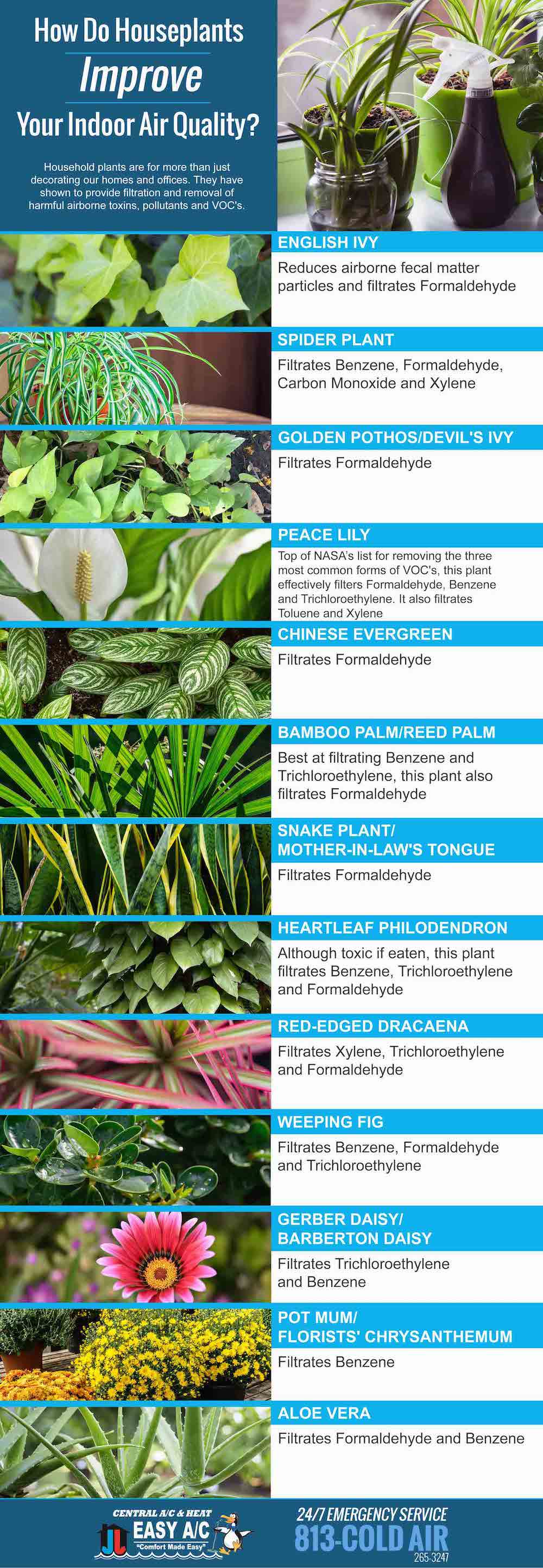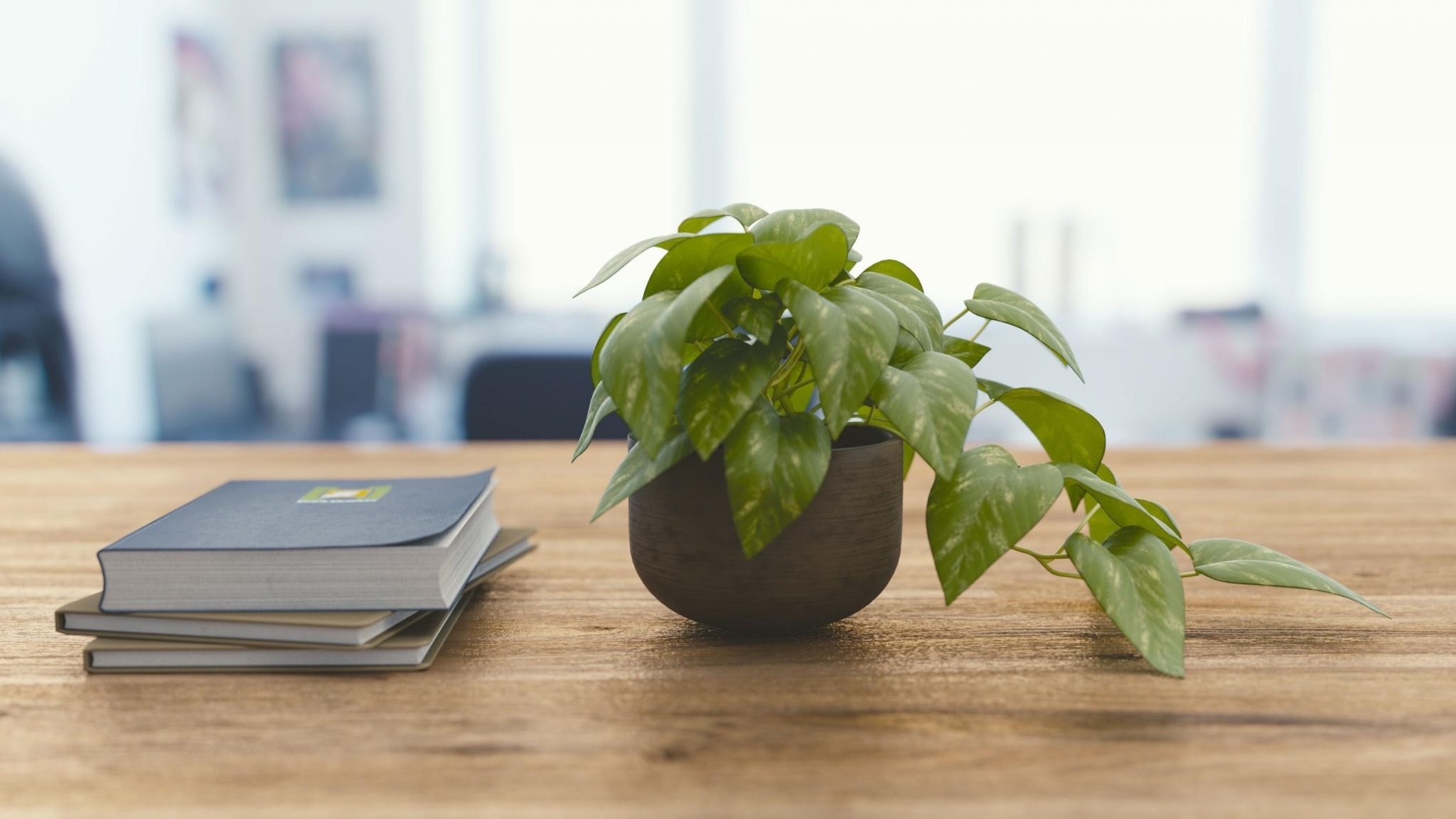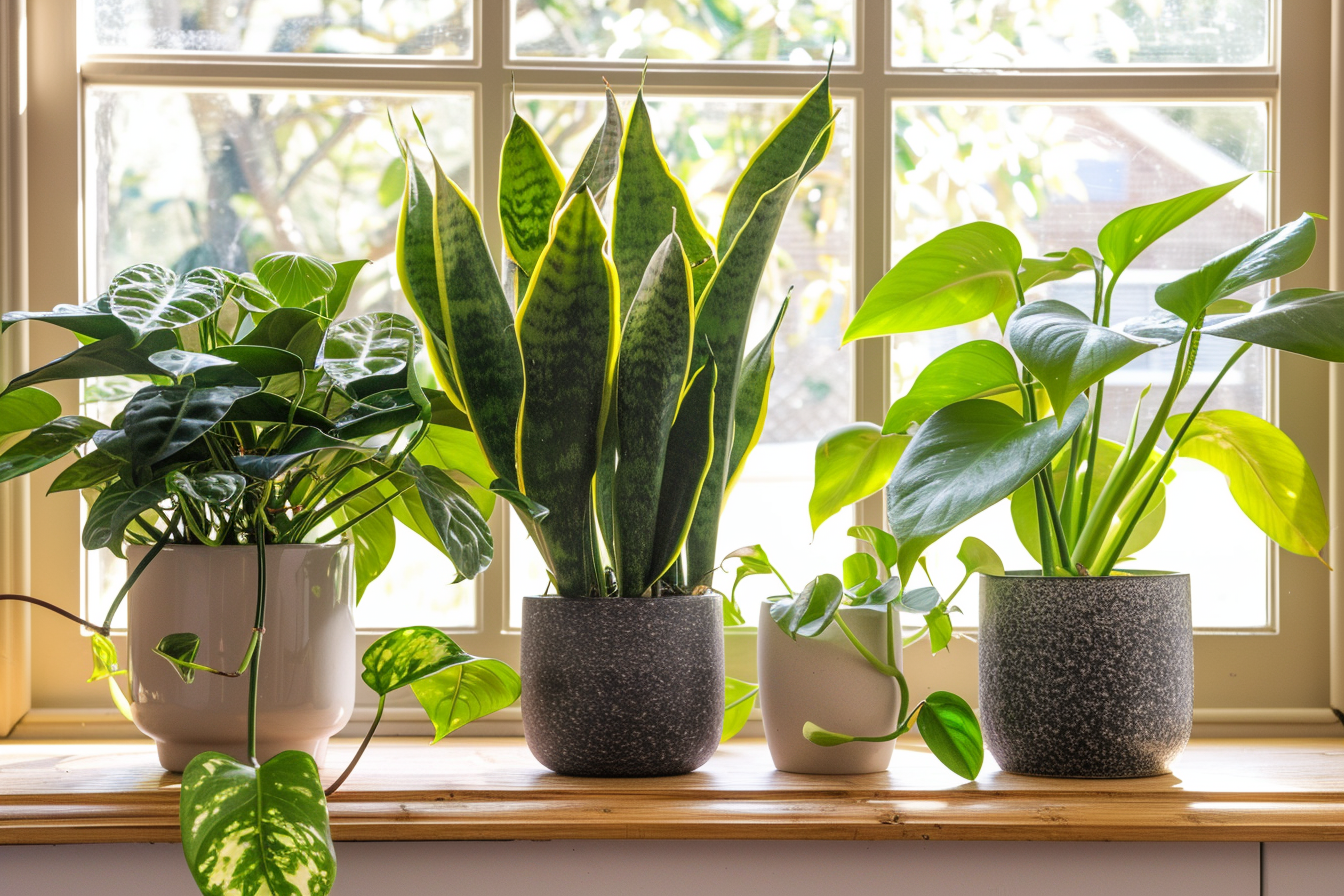Indoor air quality is crucial for our health. Plants can greatly improve it.
In today’s world, we spend a lot of time indoors. This makes the quality of indoor air very important. Harmful pollutants, dust, and toxins can affect our health. But did you know that some plants can help clean the air?
Yes, certain plants act as natural air purifiers. They absorb toxins and release fresh oxygen. Adding these plants to your home or office can create a healthier environment. Plus, they bring a touch of nature indoors. Let’s explore how plants can enhance the air we breathe and improve our well-being.

Credit: www.easyac.net
Benefits Of Indoor Plants
Indoor plants do more than beautify your home. They offer numerous benefits. From improving air quality to boosting mental health, these green friends bring nature indoors. Let’s explore the benefits of indoor plants.
Enhancing Air Quality
Indoor plants can purify the air. They absorb toxins and produce oxygen. Studies show certain plants can remove harmful chemicals. These include formaldehyde and benzene.
Consider adding these plants to your home:
- Spider Plant: Known for its air-purifying abilities.
- Peace Lily: Effective in removing toxins.
- Aloe Vera: Absorbs pollutants and releases oxygen.
Boosting Mental Health
Indoor plants have a positive impact on mental health. They reduce stress and increase productivity. Being around plants can make you feel more relaxed.
Some mental health benefits include:
- Reduced Anxiety: Plants can create a calming environment.
- Improved Mood: Greenery can uplift your spirits.
- Enhanced Concentration: Nature’s presence helps focus.
Adding indoor plants is a simple way to improve your well-being. They make your space healthier and more pleasant.

Credit: foobot.io
How Plants Clean Air
Plants improve indoor air quality by absorbing pollutants and releasing oxygen. They act as natural air filters, making spaces healthier.
Plants are natural air purifiers. They remove toxins and refresh the air. This makes them perfect for indoor spaces. They do this through various processes. Let’s explore how plants clean the air.Absorption Of Pollutants
Plants absorb harmful pollutants through their leaves. These pollutants include formaldehyde, benzene, and trichloroethylene. The roots and soil then break down these toxins. This process makes the air cleaner and safer.Release Of Oxygen
Plants release oxygen during photosynthesis. They take in carbon dioxide and produce oxygen. This process increases the oxygen levels in your home. Higher oxygen levels improve breathing and overall health.Plants not only beautify your space. They make the air you breathe healthier. Adding a few plants can transform your indoor environment. “`Top Indoor Plants For Cleaner Air
Indoor plants not only add beauty to your home but also improve air quality. Many indoor plants can filter out toxins and pollutants from the air. This helps create a healthier living environment. Here are some top indoor plants for cleaner air.
Spider Plant
The Spider Plant is a popular choice for improving indoor air. It is easy to grow and care for. Spider Plants can remove toxins like formaldehyde and xylene from the air. They also thrive in low light and need minimal watering. This makes them perfect for beginners.
Snake Plant
The Snake Plant, also known as Mother-in-Law’s Tongue, is another excellent choice. It is known for its unique, upright leaves. Snake Plants can filter out toxins like benzene, formaldehyde, and trichloroethylene. They are low maintenance and can survive in low light. Snake Plants also require little water, making them ideal for busy people.
Low Maintenance Options
Indoor plants improve air quality. Many people want low maintenance options. These plants clean the air and require little care. They are perfect for busy people. Let’s explore some of these easy-care plants.
Zz Plant
The ZZ Plant is a great choice. It thrives in low light. It also tolerates infrequent watering. The plant has shiny, dark green leaves. These leaves add a touch of elegance to any space. It is also resistant to pests and diseases. This makes it a hardy option for beginners.
Pothos
Pothos is another easy-care plant. It can grow in low light and bright light. The plant is known for its trailing vines. These vines can be trained to climb or hang. Pothos also purifies the air. It removes toxins like formaldehyde and benzene. This makes it a healthy choice for your home.
Best Plants For Small Spaces
Small spaces can benefit from the right kind of plants. They not only add a touch of nature but also help to improve indoor air quality. Here are some of the best plants that are perfect for small spaces.
Aloe Vera
Aloe Vera is a great choice for small spaces. This plant is known for its thick, fleshy leaves that store water. It does not require frequent watering, making it easy to maintain.
Aloe Vera has many benefits:
- Improves air quality by removing toxins.
- Can be used for its medicinal properties.
- Requires minimal sunlight and can thrive in low-light conditions.
English Ivy
English Ivy is another excellent plant for small areas. This climbing plant is known for its ability to purify the air. It can remove harmful pollutants, making the air healthier to breathe.
Benefits of English Ivy include:
- Removes mold and other airborne particles.
- Can grow in small pots or hanging baskets.
- Adaptable to various light conditions, from low to bright indirect light.
Pet-friendly Plants
Indoor plants can greatly enhance the air quality of your home. They add beauty and freshness to any space. For pet owners, it’s crucial to choose plants that are safe for your furry friends. Here, we explore a few pet-friendly plants that not only improve your indoor air quality but also keep your pets safe.
Areca Palm
The Areca Palm is a popular choice for many. It purifies the air and adds a touch of elegance to any room. This plant is safe for both cats and dogs.
- Height: Up to 6-7 feet indoors
- Light: Bright, indirect light
- Water: Keep soil slightly moist
Besides being pet-friendly, the Areca Palm is easy to care for. It thrives in bright, indirect light and needs regular watering. Ensure the soil stays slightly moist, and avoid over-watering. This plant effectively removes toxins such as formaldehyde and xylene from the air.
Boston Fern
Boston Fern is another excellent option for homes with pets. It’s known for its air-purifying properties and safe nature.
- Height: Up to 3 feet indoors
- Light: Indirect sunlight
- Water: Keep soil damp
Boston Ferns enjoy a humid environment, making them perfect for bathrooms or kitchens. They need indirect sunlight and should be kept in damp soil. They are effective in removing toxins such as formaldehyde and xylene. This plant is safe for both cats and dogs, making it a great addition to any pet-friendly home.
Decorative And Functional Choices
Indoor plants can improve air quality and enhance the aesthetic of any room. Choosing plants that are both decorative and functional is key. Some plants not only look good but also help purify the air. Below are some top choices that can beautify your space while boosting air quality.
Peace Lily
The Peace Lily is a beautiful plant with dark green leaves and white blooms. It is known for its ability to remove toxins like ammonia, benzene, and formaldehyde from the air. Peace Lilies thrive in indirect sunlight and require weekly watering, making them easy to maintain.
- Scientific Name: Spathiphyllum
- Light Requirements: Indirect sunlight
- Watering Needs: Weekly
- Air Purification: Removes toxins
Rubber Plant
The Rubber Plant is another excellent choice for improving indoor air quality. With its broad, glossy leaves, it can absorb airborne chemicals and convert them into harmless substances. Rubber Plants prefer bright, indirect light and need their soil to be kept moist.
- Scientific Name: Ficus elastica
- Light Requirements: Bright, indirect light
- Watering Needs: Keep soil moist
- Air Purification: Absorbs chemicals

Credit: thecameronteam.net
Tips For Plant Care
Keeping indoor plants healthy is crucial for maximizing their air-purifying benefits. Proper care ensures that plants not only survive but thrive. Below are some essential tips for plant care that will help you create a greener and healthier indoor environment.
Proper Watering
Watering your plants correctly is vital. Too much or too little water can harm them. Here are some guidelines for proper watering:
- Check the soil moisture before watering. Stick your finger about an inch into the soil. If it’s dry, it’s time to water.
- Use room temperature water. Cold water can shock the roots.
- Water thoroughly until you see water coming out of the drainage holes. This ensures the roots get enough moisture.
- Empty the saucer under the pot to prevent root rot.
Different plants have different water needs. Research the specific requirements of your plants to keep them healthy.
Adequate Lighting
Light is crucial for plant growth. Without enough light, plants cannot photosynthesize. Here are some tips for ensuring adequate lighting:
- Place plants near windows where they can get natural light. South-facing windows are ideal for most plants.
- If natural light is limited, use grow lights. These provide the right spectrum of light for plant growth.
- Rotate plants every few days. This ensures all sides get equal light exposure.
- Pay attention to the light requirements of different plants. Some need bright, indirect light, while others thrive in low light.
Proper lighting is essential for maintaining healthy and vibrant indoor plants. Keep track of your plants’ light needs to ensure they receive the right amount.
Common Mistakes To Avoid
When introducing plants into your home to improve indoor air quality, it’s crucial to avoid common mistakes. These mistakes can hinder the plant’s ability to thrive and purify the air. Let’s discuss some typical errors and how to prevent them.
Overwatering Issues
Overwatering is a frequent mistake. It can lead to root rot and unhealthy plants. Plants need a balance of water and air at their roots. Too much water can suffocate them.
To avoid overwatering, check if the top inch of the soil is dry before watering. Different plants have different water needs. Research each plant’s specific requirements.
| Plant Type | Watering Frequency |
|---|---|
| Snake Plant | Every 2-3 weeks |
| Spider Plant | Once a week |
| Peace Lily | Every 5-7 days |
Incorrect Placement
Placing plants in the wrong spot can limit their growth. Plants need the right amount of light. Some plants thrive in bright light, while others prefer shade.
For example, a Spider Plant enjoys indirect sunlight. A Peace Lily can thrive in low light areas. Always check the light needs of your plants.
Avoid placing plants near drafts or heating vents. These spots can stress the plant and affect its health.
To sum up, understanding your plant’s needs helps them thrive. This ensures they improve your indoor air quality effectively.
Frequently Asked Questions
What Are The Best Plants For Indoor Air Quality?
The best plants for indoor air quality include spider plant, snake plant, and peace lily. These plants are known for their ability to purify the air by removing toxins.
How Do Plants Improve Indoor Air Quality?
Plants improve indoor air quality by absorbing pollutants and releasing oxygen. They also increase humidity and reduce airborne dust levels, making the air cleaner.
Which Indoor Plant Requires The Least Maintenance?
The snake plant requires the least maintenance. It can thrive in low light conditions and needs minimal watering, making it ideal for busy individuals.
Can Indoor Plants Remove Toxins From The Air?
Yes, indoor plants can remove toxins from the air. Plants like peace lily and spider plant are particularly effective at eliminating harmful chemicals like formaldehyde and benzene.
Conclusion
Plants are great for improving indoor air quality. They add beauty and health benefits. Choose the right plants for your space. Easy care options include snake plants and spider plants. These plants filter toxins and freshen the air. Place them in bedrooms, living rooms, or offices.
Enjoy cleaner air and a touch of nature indoors. Breathe better and live healthier with these plants. Make your home a green oasis today. Your indoor air quality will thank you.


